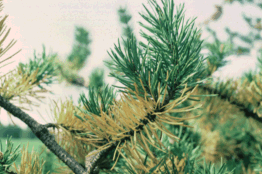 |
Nuisance
of the Week: |
|||||||||||||
|
Get Our Free Newsletter
Home
|
Our heat and drought
this year has been very tough on trees; especially some of the
evergreens. Spruce, fir and pine are not well adapted to Kansas
conditions and high stress years like this one can lead to decline and
death. However, there are natural conditions that can look like the
tree is dying that actually are not harmful. How do we tell the
difference?
How do we tell if the tree will survive? First check to see if the branch with the browning needles is alive. Scrape off a small area of the "bark" of the branch with a sharp knife. There should be green tissue immediately under the bark. This green cambium layer is quite thin with the underlying woody tissue being white. If there is no green at all, the branch is dead. Also check the ends of branches. Dry, brittle twigs are a sure sign that at least that part of the tree is dead. Dead branches should be removed. Major branch removal may destroy the aesthetics of the tree resulting in tree removal as the only viable option. What can we do to reduce stress? Concentrate on good watering. During dry weather (including winter), water the trees to a depth of at least 10 inches with deeper watering preferred. You can check the depth the water reaches by pushing a long-tanged screwdriver, metal rod or wooden dowel into the soil. It will stop when it reaches dry soil. During hot, dry weather, trees may need watered once a week. If we have an open, dry winter, water the trees once per month when the temperatures are above freezing.
Nuisance of the Week is brought to
you in cooperation with the Kansas
State University Research & Extension
|
|||||||||||||
|
© 1999 - 2009 Savvygardener.com, Inc. All rights reserved. If you wish to copy, transmit, or otherwise duplicate any of the material from our website please ask us first. Thank you. |
||||||||||||||
 If
the needles are browning just on the inside of the tree but the needles
furthest out on the branches remain green, the tree is going through
natural needle drop. Natural needle drop does not harm the health of
the tree and is a normal process as 2- and 3-year old needles are
shed. Drought may increase needle drop but this, in itself, does not
harm the tree. However, in some cases we are seeing all the needles on a
branch turn color. On pines, this may be due to pine wilt (see
below), a fatal disease that is found primarily on Scots pine.
However, the heat and drought of this summer may have stressed some of our
trees to the point that they may lose branches (and entire trees) just
because of accumulated stress.
If
the needles are browning just on the inside of the tree but the needles
furthest out on the branches remain green, the tree is going through
natural needle drop. Natural needle drop does not harm the health of
the tree and is a normal process as 2- and 3-year old needles are
shed. Drought may increase needle drop but this, in itself, does not
harm the tree. However, in some cases we are seeing all the needles on a
branch turn color. On pines, this may be due to pine wilt (see
below), a fatal disease that is found primarily on Scots pine.
However, the heat and drought of this summer may have stressed some of our
trees to the point that they may lose branches (and entire trees) just
because of accumulated stress.